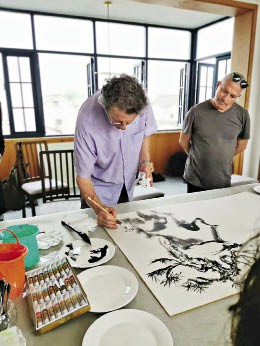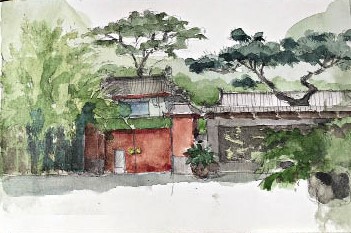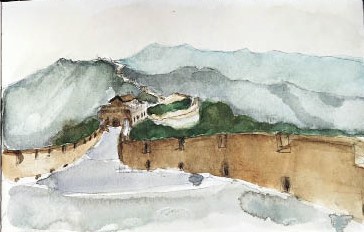
Philippe Herman Dequesne dabbles in traditional Chinese ink painting.
PHILIPPE Herman Dequesne, a Belgian painter who lives and works in Paris, was born in Brussels in 1954. After graduating with a degree in architecture, he worked for 15 years in an architectural firm until 1996 when he quit his job to take up painting.
More than 30 years ago, he met Rémy Aron, a famous French painter and a Chevalier of the French Order of Arts and Letters, and became his student. Today he creates still lifes, landscapes, interiors, and seascapes in a unique style. For more than 20 years, he has exhibited his art work in France, Belgium, the U.S., and recently in China.
He has come to China to hold painting exhibitions three times over the past three years. The trip to China profoundly modified his vision of the world and thereby impacted his artistic creation. “Since my return to Paris, I continue to paint what I see, but also like my Chinese friends, add a little bit of poetry,” he said.
Wenzhou: Meeting Chinese Artists
and Villagers
In May 2018, Dequesne arrived in Wenzhou in southern China for the first time, as part of the event “Painting and Nature: When Paris Meets Wenzhou,” which brought together nine Chinese artists and nine French artists. It was initiated by Zhou Jianpeng and Rémy Aron, president of the French Association of Plastic Arts.
In Wenzhou, one of the big cities of Zhejiang Province with a developed economy and rich natural and cultural resources, artists from both countries spent two busy weeks together on thematic exhibition, academic exchanges, and painting inspired by local sights.
“In Wenzhou, I had the chance to participate in a meeting between Chinese and French artists on the theme of landscape painting. It was not possible for each of us to paint like each other, but we were able to engage in an exchange while preserving the features of each individual in dialogue, sharing, and friendship,” said Dequesne.
During their stay, the artists were accommodated at the Ruoxi Art Village, which was built in Shangrichuan Village, the hometown of Zhou Jianpeng, who hopes to bring new development impetus to the countryside by introducing arts. In this small village surrounded by mountains and passed through by the Ruoxi River, the artists went out during the day to paint in the fields, vegetable gardens, and all around the village, and in the evening, they sang, danced, and mingled with the villagers in a relaxed atmosphere.
“I am very happy to have shared for a brief period of time the life of this village where I have met some very friendly inhabitants. We received a warm welcome from our hosts as well as all the villagers who showed exceptional hospitality so much so that we have become honorary residents of Ruoxi Art Village,” he said.
This journey resulted in the creation of many works which were then exhibited at the “Exhibition of Sino-French Artists’ Paintings on Nature in Wenzhou” that opened on April 4, 2019, at the Town Hall of Versailles, highlighting a perfect end to these exchanges inaugurated in February 2018.
Nevertheless, the exchanges between the artists are far from over.

A watercolor painting Philippe Herman Dequesne completed during his stay in China.

A watercolor painting of the Great Wall by Philippe Herman Dequesne.
Suzhou: “The City Which Reminds
Me of My Hometown”
Dequesne returned to China in June 2019, to Suzhou, Jiangsu Province, nicknamed “Heaven on Earth” and known for its traditional gardens. He came for the event “I Paint Suzhou,” which brought together eight Chinese painters and eight French painters including Pierre Le Cacheux, interim president of French Association of Plastic Arts, Jean-Daniel Bouvard and Clémentine Odier, who all took part in the Wenzhou event a year before.
Liu Zhongjun, secretary general of French Association of Plastic Arts and manager of the Galerie Francis Barlier in Paris, worked as a manager in the organization of Western artists and chief performer during these two events in Wenzhou and Suzhou. “The two events were organized similarly, but every time there is something new,” said Liu.
“I stayed in the ancient city of Suzhou with a group of painters from France to meet Chinese painters, with the objective of painting on the motif in traditional gardens, in the streets of the city, and along the canals,” recalled Dequesne.
Like other Western artists, Dequesne was impressed by the preservation of the ancient city of Suzhou which reminded him of Bruges in Belgium, his hometown; as both are built of stone and brick on the water. “They say that Bruges is the Venice of the North... and we could add that Venice is the Suzhou of Italy!”
Beyond the splendor of the canal, the part that impressed him most was the spatial design of the traditional gardens. He observed, “They look immense even though they are sometimes built on very small plots.” According to him, to paint these gardens of elaborate designs shaped by philosophy is to try to understand this relation of proportion. “Both painting and philosophy take the interpretation of the world as their basic theme,” he mused.
After 10 days of discussion and creation, 39 works by artists from both sides were exhibited in Suzhou, allowing local citizens to rediscover their city through the brush tips of artists from afar. On this occasion, Dequesne donated one of his paintings to Suzhou, which evoked a certain nostalgia in him.
Beijing: Solo Exhibition and a
Boy’s Friendship
For Zhou Jianpeng, Dequesne’s works present a simplistic style that he greatly admires: “His painting style is very simple; it is often the relationship between a few blocks of colors, carefully cut by geometric shapes.” Liu Zhongjun, echoing similar sentiments, added, “An extremely simple style, but very rich at the same time. I like it a lot.” According to Zhou, the artist’s simplicity is consistent with that of his way of life: “Philippe leads a very simple life which has almost nothing other than painting, apart from the horse racing he goes to on weekends.” Dequesne himself readily admitted, “I divide my time between painting and horse racing, which give me a share of humility and rurality, both of which are necessary in this urban life.”
In August 2019, at Zhou’s invitation, Dequesne held a solo exhibition at the Hongluo Academy located in Huairou District, on the outskirts of Beijing, an experience that allowed him to travel to a city in northern China, discovering landscapes different from those of the southern regions he had visited.
He really likes the time-honored Hongluo Temple. “The temple envelops the visitor in a sacred space, and all the calm of the mountains around is impressive with the softness of its paths in the tree shade in summer, at the same time so close to downtown Beijing.”
In addition, he visited the Forbidden City, surprised by its massiveness and its architecture which defies centuries of history,” the Great Wall in front of which “the emotion is obviously overwhelming,” the Temple of Heaven, 798 Art District, Yanxi Lake, etc. Among those who accompanied him to visit these attractions, there was one he would particularly mention — a seven-year-old Chinese boy named Liangzi.
“The child is very attentive and curious about all things in general and especially about art. He showed his desire to learn to paint and he observed me a lot.” Despite the language barrier, Dequesne got along well with this child who came to spend a few days at the academy with his mother during summer vacation. They spent a lot of happy moments together.
“I will not forget the time when I accompanied him on a fishing trip. We only caught a very small fish that night, to the great pleasure of Liangzi. We made a promise to do better next time,” recalled Dequesne.
Before his departure, Dequesne painted a painting of the temple to give to Liangzi as a gift, while Liangzi and his mother gave him a box of Chinese brush pens in return.
“I really want to learn a little French and go to Paris, to visit him and his horse,” Liangzi said in an article written by his mother recounting his experiences with Dequesne.
China: A Great Opportunity for the
Future of Painting in the World
For Dequesne, the trip to China gave him a better understanding of the country and especially its artistic development.
“It was an incredible chance for me to come to this country of elegance and to be able to interact with people who believe in development through art and culture.” He is delighted to have met art lovers, whether they be practitioners or amateurs, “Because in China, the people love art and everything beautiful.”
According to him, China is a great opportunity for the future of painting in the world. “In a rapidly growing China, I have met painters who stick to thousands-year-old heritage, who learn and stay true to the things that shape their identity.” It seems to him that today in China, people have the possibility of continuing to have classical education, to copy from the previous generations. “Masters are respected. We can draw from nature, we paint from a model, and we paint portraits and landscapes on the motif,” a tradition that the West is losing to what is called “contemporary art,” according to Dequesne. “This situation is appalling,” he sighed.
Raising awareness of this situation is also the objective of organizing nature painting trips to China, according to Zhou. He said that is an opinion shared by Rémy Aron as well. Chinese and Western artists need to find possible spaces for artistic freedom and that is why they organized such cross-cultural exchanges to rediscover the tradition of painting on the motif.
A form of exchange applauded by the participating artists, both Chinese and Western, as Dequesne said about his stay in Wenzhou, “We are working together with the same concern to create aesthetics by observing the flow of light and shadow. It is through exchanges of this type that painters and the people come together in peace.”
As for which Chinese cities and regions he would like to visit next time, Dequesne said there are so many beautiful destinations to discover in China, and that, “When I come back, I would like to see my Chinese friends first and will ask them to guide me! I would also like to meet horsemen, to draw them.”